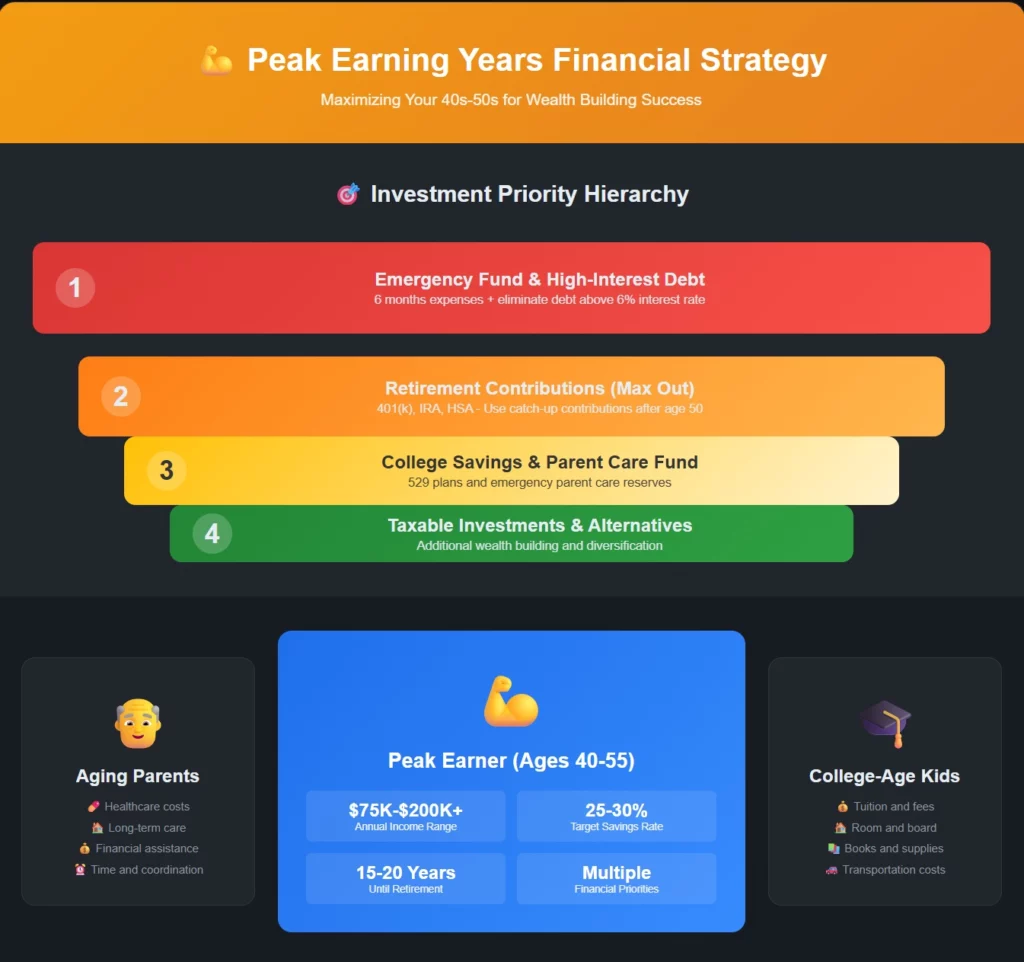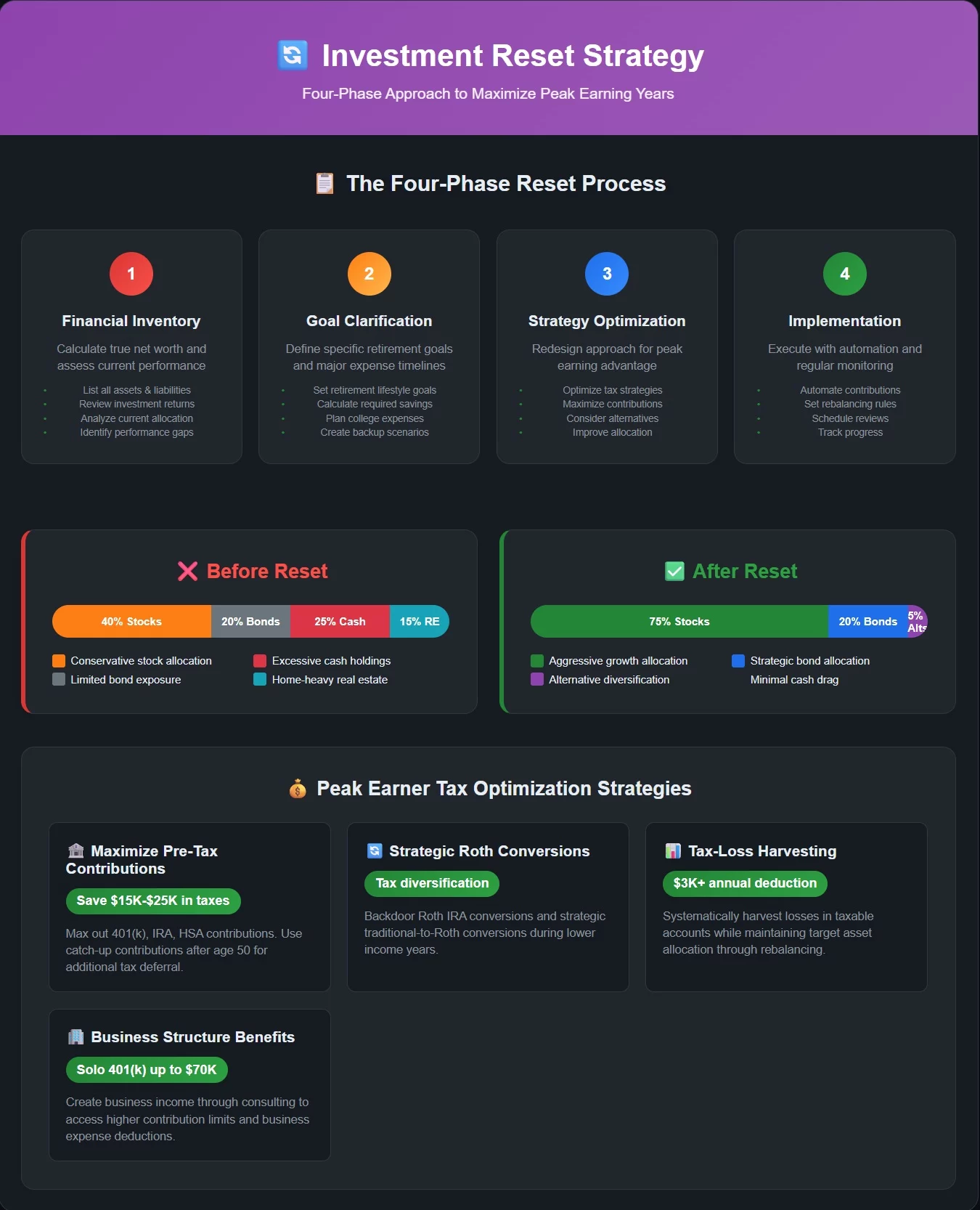I began trading in 2015 and started coaching in 2019. Peak earning years create unique investment opportunities and challenges. However, this decade often gets wasted on lifestyle inflation instead of wealth acceleration. Therefore, this guide helps you maximize your highest-income years strategically.
👉 In this guide, you will learn:
- 💰 Why your 40s-50s offer the best wealth-building window
- 🎯 How to reset your investment strategy for peak earnings
- 📊 Advanced tax strategies that high earners must understand
- 🏠 Balancing college costs, elderly parents, and retirement
- 🚀 Catch-up contribution strategies that accelerate wealth building
- 💎 Investment approaches specifically designed for peak earners
- ⚖️ How to manage multiple financial priorities simultaneously
Peak earning years represent your last chance to build serious wealth before retirement. Unfortunately, most people waste this opportunity on unnecessary spending. Additionally, complex financial priorities often create analysis paralysis instead of action.
Table of Contents
Your Peak Earning Years: The Make-or-Break Decade 🎯
The years between 40-55 typically represent peak earning potential for most professionals. During this period, salaries reach their highest levels while major expenses begin declining. Furthermore, career advancement opportunities maximize income growth potential significantly.
Why these years matter most for wealth building:
- 💵 Highest salary years provide maximum investment capacity
- 🏠 Housing costs stabilize after initial purchase and refinancing
- 🎓 Professional development investments pay off through promotions
- 💡 Experience enables better investment decision-making
- ⏰ Sufficient time remains for compound growth before retirement
However, this decade also brings unique financial pressures. Meanwhile, college expenses for children create enormous cash flow demands. Additionally, aging parents may require financial assistance or care coordination.
Common financial pressures during peak earning years:
- 👨👩👧👦 College tuition and education expenses for children
- 👴 Elderly parent care costs and potential financial support
- 🏠 Mortgage payments on larger homes in better school districts
- 💼 Professional expenses and continued education requirements
- 🚗 Multiple car payments and higher insurance costs
Smart peak earners recognize these pressures but refuse to let them derail wealth building. Instead, they develop systematic approaches that address all priorities simultaneously.
The Investment Reset Strategy 🔄
Many people reach their peak earning years with suboptimal investment strategies. Perhaps they started late, made costly mistakes, or simply never developed coherent plans. Furthermore, strategies that worked in their 30s may prove inadequate for peak earning potential.
Signs you need an investment reset:
- 📉 Your investment returns lag market performance consistently
- 💰 You save less than 20% of your peak-year income
- 🎯 No clear retirement number or timeline exists
- 📊 Investment allocation ignores your changing risk tolerance
- 🏠 Real estate represents over 50% of your net worth
An investment reset involves completely reassessing your financial situation and goals. Moreover, it requires honest evaluation of past mistakes and current shortcomings. Additionally, it demands commitment to systematic improvement moving forward.
The four-phase reset process:
Phase 1: Financial Inventory and Assessment Calculate your true net worth including all assets and liabilities. However, use realistic valuations rather than optimistic estimates. Furthermore, assess your current investment allocation and performance honestly.
Phase 2: Goal Clarification and Timeline Development Define specific retirement lifestyle goals with corresponding financial requirements. Additionally, establish timelines for major expenses like college tuition. Moreover, create backup plans for potential career disruptions or health issues.

Phase 3: Strategy Optimization for Peak Earnings Redesign your investment approach to maximize the advantage of high income. Furthermore, implement tax strategies that become available at higher income levels. Additionally, consider alternative investments that require larger minimum investments.
Phase 4: Systematic Implementation and Monitoring Execute your new strategy with automatic systems and regular reviews. However, avoid constant tinkering that undermines long-term performance. Moreover, adjust only when circumstances change significantly or goals evolve.
Advanced Tax Strategies for Peak Earners 🧾
High income creates both opportunities and obligations in tax planning. Therefore, peak earners must understand strategies unavailable to lower-income investors. Furthermore, tax optimization becomes increasingly important as marginal rates climb.
High-Income Tax Planning Essentials
Maximize Pre-Tax Retirement Contributions Peak earners can contribute up to $70,000 annually to retirement accounts in 2025. Furthermore, catch-up contributions allow additional deferrals after age 50. Additionally, business owners can implement even more generous plans.
Contribution limits for peak earners:
- 🏦 401(k): $23,500 + $7,500 catch-up = $31,000
- 🏦 Solo 401(k): Up to $70,000 with business income
- 🏦 IRA: $7,000 + $1,000 catch-up = $8,000 (if income qualified)
- 🏦 HSA: $4,300 + $1,000 catch-up = $5,300
Strategic Roth Conversion Opportunities Peak earners often earn too much for direct Roth IRA contributions. However, backdoor Roth conversions remain available regardless of income. Moreover, strategic conversions during lower-income years can prove beneficial.
Roth strategies for high earners:
- 💰 Backdoor Roth IRA conversions annually
- 💰 Roth 401(k) contributions for tax diversification
- 💰 Strategic conversions during sabbaticals or career transitions
- 💰 Mega backdoor Roth through after-tax 401(k) contributions
Tax-Loss Harvesting Optimization Higher tax brackets make tax-loss harvesting more valuable. Furthermore, peak earners typically have larger taxable portfolios requiring active management. Additionally, sophisticated strategies can generate significant annual tax savings.
Advanced harvesting techniques:
- 📊 Systematic harvesting with automatic rebalancing
- 📊 Asset allocation optimization across account types
- 📊 Municipal bond strategies for high-tax states
- 📊 Direct indexing for enhanced loss harvesting
Business Ownership Tax Advantages
Many peak earners can benefit from business structures even for side income. Therefore, consulting work or small business ownership unlocks additional strategies. Furthermore, business expenses can reduce taxable income significantly.
Solo 401(k) and Defined Benefit Plans Business income enables much higher retirement contributions. Moreover, defined benefit plans can allow contributions exceeding $200,000 annually. Additionally, these plans work especially well for high-income professionals.
Business Expense Deductions Legitimate business expenses reduce taxable income dollar-for-dollar. Furthermore, many peak earners can deduct home office, equipment, and travel expenses. Additionally, business structure enables health insurance deductions for self-employed individuals.
The Sandwich Generation Investment Challenge ⚖️
Peak earners often face competing demands from both children and parents simultaneously. Therefore, investment strategies must account for multiple financial priorities. Furthermore, emotional decision-making can undermine long-term wealth building.
Managing Multiple Financial Priorities
College Funding Without Sacrificing Retirement Many parents prioritize college savings over retirement planning mistakenly. However, children can borrow for education while parents cannot borrow for retirement. Therefore, retirement funding should typically receive priority.
Strategic college funding approaches:
- 🎓 Fund retirement first, then college savings
- 🎓 Use 529 plans for tax-advantaged education savings
- 🎓 Consider direct tuition payments to avoid gift taxes
- 🎓 Explore merit scholarships and in-state options aggressively
Elderly Parent Care Planning Aging parents may require financial assistance or care coordination. Furthermore, these costs can be substantial and unpredictable. Additionally, emotional factors often override financial logic in these situations.
Parent care financial strategies:
- 👴 Understand Medicare and Medicaid eligibility requirements
- 👴 Consider long-term care insurance for both parents and yourself
- 👴 Explore family care agreements and tax implications
- 👴 Plan for potential inheritance while managing care costs
Emergency Fund Optimization Peak earners need larger emergency funds due to higher fixed expenses. However, keeping too much cash reduces investment returns significantly. Therefore, optimized emergency fund strategies become crucial.
Emergency fund alternatives for peak earners:
- 💰 High-yield savings for 3-6 months basic expenses
- 💰 Home equity lines of credit for additional liquidity
- 💰 Taxable investment accounts with conservative allocation
- 💰 Cash value life insurance for additional access
Peak Earning Years Portfolio Construction 📈
Investment strategies must evolve during peak earning years to maximize wealth accumulation. Therefore, portfolios should become more sophisticated as income and knowledge increase. Furthermore, risk tolerance often changes as retirement approaches.
Asset Allocation for Peak Earners
Age-Appropriate Stock Allocation Traditional rules suggest reducing stock allocation with age. However, peak earners with secure income can often maintain aggressive allocations longer. Moreover, longer life expectancies require more growth orientation.
Suggested allocation ranges for peak earners:
- 📊 Ages 40-45: 80-90% stocks, 10-20% bonds
- 📊 Ages 45-50: 75-85% stocks, 15-25% bonds
- 📊 Ages 50-55: 70-80% stocks, 20-30% bonds
- 📊 Adjust based on secure pension income and risk tolerance
International Diversification Enhancement Peak earners can access international investments more easily. Furthermore, global diversification becomes increasingly important as portfolios grow. Additionally, international exposure can reduce overall portfolio volatility.
International allocation strategies:
- 🌍 25-35% of stock allocation in international markets
- 🌍 Include both developed and emerging market exposure
- 🌍 Consider currency hedging for portion of international holdings
- 🌍 Access international markets through low-cost index funds
Alternative Investment Consideration Larger portfolios justify alternative investment exploration. However, alternatives should complement rather than replace core holdings. Moreover, due diligence becomes crucial as complexity increases.
Alternative investments for peak earners:
- 🏠 REITs for real estate exposure and income
- 💎 Commodities for inflation protection and diversification
- 🏢 Private equity through interval funds or direct access
- 💰 Hedge fund strategies through liquid alternatives
Tax-Efficient Portfolio Management
Asset Location Optimization Peak earners typically have multiple account types requiring strategic asset location. Therefore, tax-inefficient investments should go in tax-advantaged accounts. Furthermore, tax-efficient investments work better in taxable accounts.
Asset location guidelines:
- 🏦 Tax-advantaged accounts: Bonds, REITs, active funds
- 🏦 Taxable accounts: Index funds, individual stocks, municipal bonds
- 🏦 Roth accounts: Highest growth potential investments
- 🏦 Regular IRAs: Income-producing conservative investments
Municipal Bond Strategies High tax brackets make municipal bonds attractive for peak earners. Furthermore, state-specific municipal bonds can avoid both federal and state taxes. Additionally, municipal bonds provide portfolio diversification benefits.
Municipal bond considerations:
- 💰 Compare after-tax yields to taxable alternatives
- 💰 Consider state-specific bonds for additional tax benefits
- 💰 Evaluate credit quality and duration risk carefully
- 💰 Use municipal bond funds for diversification
Catch-Up Strategies for Late Starters 🚀
Many peak earners recognize they started investing too late or too conservatively. However, high income during peak years can overcome previous inaction. Therefore, aggressive catch-up strategies become essential for retirement security.
Maximizing Catch-Up Contributions
Age 50+ Contribution Bonuses Federal law allows additional retirement contributions after age 50. Furthermore, these catch-up contributions can significantly accelerate wealth building. Additionally, high earners benefit most from tax-deferred strategies.
Catch-up contribution opportunities:
- 💰 401(k) catch-up: Additional $7,500 annually
- 💰 IRA catch-up: Additional $1,000 annually
- 💰 HSA catch-up: Additional $1,000 annually
- 💰 SIMPLE IRA catch-up: Additional $3,500 annually
Aggressive Savings Rates for Catch-Up Late starters may need to save 30-40% of income during peak earning years. However, high income makes these savings rates achievable without lifestyle sacrifice. Moreover, temporary aggressive savings can compensate for lost time.
Catch-up savings strategies:
- 📈 Direct raises and bonuses entirely to investments
- 📈 Maintain lifestyle while increasing savings with income growth
- 📈 Use windfalls like inheritances or business sales strategically
- 📈 Consider geographic arbitrage through relocation
Working Longer Strategies
Phased Retirement Planning Many peak earners can extend their careers through consulting or part-time work. Furthermore, delayed retirement dramatically improves financial security. Additionally, continued income allows portfolio growth without withdrawals.
Phased retirement benefits:
- ⏰ Delayed Social Security increases benefits by 8% annually
- ⏰ Additional years of high earnings improve pension calculations
- ⏰ Health insurance continuation through employer plans
- ⏰ Continued portfolio growth without retirement withdrawals
Skills Development for Career Extension Peak earners should invest in skills that enable career extension. Therefore, technology training and industry certifications maintain competitiveness. Furthermore, networking and reputation building create consulting opportunities.
Video Recommendation 🎥
🎬 For comprehensive guidance on peak earning year strategies, watch my Successful Tradings video about maximizing wealth during your highest income decade. The video demonstrates practical catch-up techniques and tax optimization strategies. Moreover, it shows real examples of successful peak-year wealth acceleration.
Watch it here: https://www.youtube.com/@SuccessfulTradings and search for “Peak Earning Years Investment Strategy.”
You will learn specific techniques that maximize your final wealth-building opportunity before retirement.
Common Peak Earning Year Mistakes 🚨
Understanding typical mistakes helps peak earners avoid costly errors. Furthermore, these mistakes can derail retirement plans despite high income. Therefore, awareness and prevention prove crucial for financial success.
Lifestyle Inflation Trap
The Gradual Creep of Higher Expenses Peak earning years often coincide with lifestyle upgrades that seem reasonable individually. However, collectively these upgrades can consume entire salary increases. Moreover, lifestyle inflation proves much easier than lifestyle deflation.
Common lifestyle inflation examples:
- 🏠 Larger homes in expensive neighborhoods for school districts
- 🚗 Luxury car payments and premium insurance coverage
- ✈️ Expensive vacations and premium travel accommodations
- 🍽️ Fine dining and expensive entertainment preferences
Keeping Up with High-Earning Peers Professional success often involves socializing with other high earners. Therefore, spending pressure increases through social comparison. Furthermore, what seems normal in professional circles may be excessive objectively.
Peer pressure spending categories:
- 🏌️ Country club memberships and premium recreational activities
- 👔 Designer clothing and expensive professional wardrobes
- 🏠 Premium home improvements and landscaping services
- 🎓 Expensive private schools and extracurricular activities
Investment Complacency
Assuming High Income Guarantees Security Many peak earners become complacent about investment strategy. However, high income alone does not guarantee financial security. Moreover, job loss or disability can end peak earning years suddenly.
Warning signs of investment complacency:
- 📉 Neglecting portfolio rebalancing and optimization
- 💰 Keeping too much money in low-yield savings accounts
- 📊 Failing to increase investment allocation as income grows
- 🎯 Lacking specific retirement goals and progress tracking
Overconfidence in Individual Stock Picking Peak earning years often coincide with overconfidence in investment abilities. Therefore, successful professionals may assume they can beat market returns consistently. However, stock picking typically underperforms diversified index investing.
FAQs 🤔
How much should I save during my peak earning years? Aim for 25-30% of gross income, including all retirement contributions. Peak earners often need higher savings rates to compensate for late starts or aggressive retirement goals.
Should I prioritize college savings or retirement contributions? Prioritize retirement first since children can borrow for education while you cannot borrow for retirement. Max out retirement accounts before contributing to 529 plans.
How do I balance caring for elderly parents with my own retirement? Set clear boundaries on parent financial support while exploring all available resources. Consider long-term care insurance for both parents and yourself.
What’s the biggest mistake peak earners make? Lifestyle inflation that consumes salary increases instead of directing them to investments. Maintaining your pre-peak lifestyle while investing raises maximizes wealth building.
How aggressive should my investment allocation be in my 40s-50s? Most peak earners can maintain 70-90% stock allocation depending on job security, pension income, and risk tolerance. Higher secure income enables more aggressive allocation.
Should I pay off my mortgage early or invest the money? Generally invest unless mortgage rates exceed 6-7%. Tax deductibility and low rates make mortgages cheap money compared to investment returns.
How do catch-up contributions work after age 50? You can contribute additional amounts beyond normal limits to 401(k), IRA, and HSA accounts. These bonuses help late starters accelerate retirement savings significantly.
What alternative investments should peak earners consider? REITs, commodities, and conservative alternative strategies can enhance diversification. Avoid complex alternatives unless you understand them thoroughly and have substantial liquid assets.
Conclusion
Peak earning years represent your final opportunity to build substantial wealth before retirement.
Therefore, strategic investment planning becomes crucial during this decade.
Furthermore, avoiding lifestyle inflation while maximizing tax-advantaged contributions can dramatically improve retirement security.
Success requires balancing multiple competing priorities while maintaining focus on long-term wealth building.
Additionally, sophisticated tax strategies and investment approaches become available at higher income levels.
Finally, catch-up opportunities exist for late starters willing to save aggressively during their highest-income years.

Hold a Master Degree in Electrical engineering from Texas A&M University.
African born – French Raised and US matured who speak 5 languages.
Active Stock Options Trader and Coach since 2014.
Most Swing Trade weekly Options and Specialize in 10-Baggers !
YouTube Channel: https://www.youtube.com/c/SuccessfulTradings
Other Website: https://237answersblog.com/
